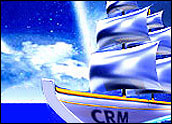
If you asked each member of yoursales team what problem your company solves, what value you provide, and how you differentiate yourselves from your competitors, would their answers be clear, consistent and compelling?
Most likely, you would receive a range of inconsistent responses. Today’s salespeople are dealing with unprecedented levels of complexity — the competitive environment, the breadth of available solutions, and customer needs are all in a constant state of flux. As a result, salespeople face an ongoing struggle to articulate their company’s unique value and differentiation.
The Right Stuff
In the face of all these changes, the emerging field of sales enablement focuses on frontline salespeople, allowing them to stay on top of these expanding responsibilities while freeing up more time to actually get out there and sell.
Put simply, sales enablement is the process of equipping a sales team with the right value proposition, for the right audience, in the right format, at the right time. This year, a “perfect storm” is brewing to set the stage for 2007 to be the year of sales enablement.
First, all companies, regardless of whether they are B2B (business to business) or B2C (business to consumer), are transforming their sales processes from product-based selling to customer-centric solution selling, which leverages a more consultative approach. At the same time, companies are realizing that it’s not good enough to simply “tell” salespeople to sell solutions — they must enable them to do so.
Second, as a result of many painful CRM (customer relationship management) deployments, sales executives are demanding that any tool deployed to their sales teams provide tangible value for the frontline salesperson. Third, the Software as a Service (SaaS) model has been proven, beyond any doubt, to be a rapid, cost-effective, scalable and secure method of deploying enterprise applications.
Both sales andmarketing leaders are looking for solutions to enable their sales teams to deliver the right value proposition for the right client at the right time. A Web-based sales enablement application makes this process easier, helping salespeople identify the best-selling materials and customize the content for a specific sales situation.
Sales enablement applications are geared toward frontline salespeople, allowing them to create customer-centric assets for their specific selling situation. At the same time, management and marketing enjoy a never-before-seen visibility into how specific materials or content impact sales performance.
The Data Trail
A salesperson can spend hours preparing materials for a customer conversation, identifying relevant customer data and then updating and reformatting that information. These materials can be automatically generated using a sales enablement application. The salesperson then has more time to develop astrategy, while management can be assured of a consistent, high-quality presentation that is specifically tailored to the client.
Sales enablement applications can save salespeople countless hours that they can then reinvest in higher-value selling activities. Further, the targeted sales pieces dramatically improve the salesperson’s ability to communicate value and differentiation in clear, consistent and compelling ways.
The “sales enabled” organization is one in which sellers are easily equipped to engage in effective conversations with customers, marketers are empowered to be marketers, and management has the visibility to control what messages are delivered into the market.
All these features help solve a common problem that some companies don’t even realize exists. The evidence of this struggle is in the numbers — the American Marketing Association, the CMO Council, and other industry thought leaders have found that today’s salespeople leverage less than half of the materials created for them by their marketing team.
Instead, salespeople spend approximately 40 percent of their time preparing customer-facing deliverables, only 10 to 20 percent of which are both compelling to customers and consistent with corporate messaging.
Companies that quickly purchased CRM systems and other enterprise initiatives in the late 1990s, only to see disappointing adoption rates and poor ROI, are now turning to this emerging field to mine new benefits from this existing technology. The sales enablement applications rising to the top in 2007 will integrate seamlessly with many widely used CRM applications, giving salespeople direct benefits from providing and maintaining CRM information.
Important Benefits
These same capabilities can also be embedded in a company’s existing CRM system, providing several key benefits for salespeople:
- All sales enablement functions are accessible within the organization’s existing CRM system. This capability dramatically reduces the number of applications and information sources a salesperson needs to access to generate customer-specific assets.
- The “sales enabled” CRM system can leverage data to proactively recommend the most relevant sales assets. As more and more content gets dumped into increasingly complex portals, today’s salespeople are facing more challenges just to locate the most effective selling materials. Most now prefer to have content proactively recommended to them based on the details of their selling situation.
- CRM data can be leveraged to automatically populate customer-specific assets. In addition to using customer data to recommend the best sales pieces, leading sales enablement applications will also use this data to prepopulate designated fields within sales collateral, creating a customized, effective piece.
- Any change made to account, customer or opportunity data within the sales enablement application is automatically updated throughout the existing CRM system. Again, this reduces the number of applications a salesperson must access to fulfill maintenance responsibilities. Further, this allows salespeople to maintain accurate, up-to-date customer information as part of normal sales activities, such as preparing a presentation, instead of having to set aside time to maintain data.
- When integrated with CRM data, the best sales enablement applications can correlate sales asset usage to actual sales performance. This visibility allows for marketing and management to track compliance and continuously improve the quality of corporate sales pieces, optimizing a company’s marketing investment.
The “sales enabled” CRM system provides new levels of efficiency and effectiveness in many of the client-focused business processes salespeople face each day.
These sales enablement-based solutions to common sales and marketing issues are driving a dramatic shift within the CRM industry. Through the years, management has seen that frontline user adoption is the most reliable indicator for predicting ROI, and sales applications have finally followed suit.
These developments can help solve a longstanding disconnect between sales and marketing, which has become perhaps the largest obstacle for organizations seeking to maximize their revenue growth — and the greatest opportunity to truly harness the power of a frontline sales team.
John Aiello, cofounder and CEO of The SAVO Group, oversees marketing, sales and operations, and is the firm’s chief evangelist for the concept of marketing and sales collaboration around revenue generation.














































